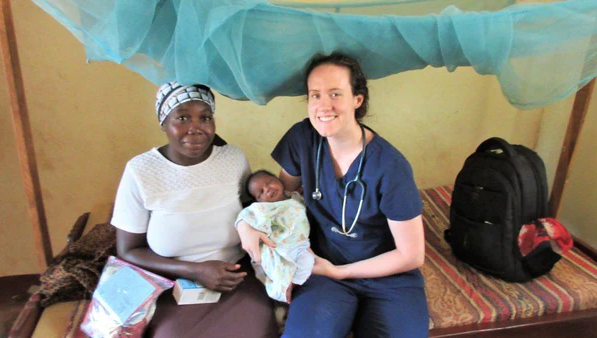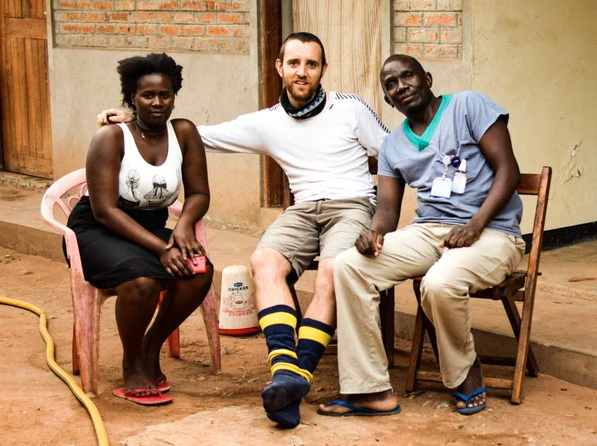July 10, 2018 • Sarah Rubino • South Sudan

Sarah Rubino is a nurse and midwife volunteering in South Sudan at St. Theresa Hospital. Both her and her husband, Martin, are Aurora Fellows and have been serving since May 2018.
In this honest and heartbreaking piece, Sarah writes about what she has learned so far about the reality of motherhood in South Sudan. It is a story of loss, love, and hope. It speaks to the complexity of healthcare in places like South Sudan.
Nzara, South Sudan holds a vast spectrum of pure emotion, from crushing grief to piercing joy.
Within the first week of living in Nzara, I saw firsthand how heart-wrenching, devastating, and beautiful motherhood can be.
I began my first full day at St. Theresa hospital with Dr. Matthew Jones as he made his rounds at the children’s ward. It was a bright and cheery morning, but even the light couldn’t quite reach all the corners of that building. As a bell rang, signalling the parents to gather their children, l looked around and saw 45 beds in one room, all lined up with about two feet between them. The doctor began rounds. He went bed to bed, efficiently examining each child while talking to their mothers in the local Zande. An aid was there to clarify the nuances of the language. Everything went by in a blur as my mind worked to understand words that I had never heard before.


Looking back, I’m not sure when the bright and cheery morning turned into an urgent fight to save two children. In a moment of confusion between the languages, we were directed to a mother standing in the doorway with a child in her arms. The child looked to be two years old and was making little sounds with every breath, almost like a soft cry. As I heard that, dread formed in the pit of my stomach. I knew that sound too well. Back in America, I was at the bedside of many elderly patients who made a similar noise, all very close to death as their body started to shut down. I knew the death of children was a reality in Nzara, but I didn’t think I would see it so soon. I didn’t know what was wrong with the child but could tell by the mother’s worried expression that the situation was dire.
A whirlwind of urgency erupted. The child had a dangerously low hemoglobin – low iron as a result of malaria. The mother was unable to give blood, and she had no family with her to be tested to see if they were a match. As we were looking into the notes of this child, another younger child lay in her mother’s arms in the nurse’s room with a nasal cannula – oxygen tube in her nose (the only way we had to give the child oxygen). Her breath was labored with retractions – a very ominous sign. She stared off into space, almost like she was at peace with death coming her way. The mother looked at me and I could see that she knew the end was near for her child. Her baby also needed a lifesaving blood transfusion, but the mother was not a match.
For both of these children, there was no time to find other family members, and we had no extra blood in storage. Both children could receive O positive blood, we just needed the donors that could help save them. Dr. Matthew called someone nearby that was O positive. I couldn’t remember exactly, but I thought my husband’s blood was O positive as well. I rushed to the construction site to find him, urgency building as we ran together to the lab building to start the match and screening process.

Martin at the worksite of the new surgical wing of St. Theresa Hospital.
The man Dr. Matthew called had arrived – he, like my husband, was a match. A little bit of tension left the lab room – we had found two donors. It seemed like time was dragging on as we waited for the screening process to finish. Off in the distance, in the same direction as the children’s ward, I heard a gut-wrenching sound. “Please, no!” I thought to myself, as I walked towards the wailing, hoping, praying that the children were still alive. As I rounded the corner, I saw the mother of the first child holding something wrapped in her arms. The child had died. Little legs dangled from the mother’s arms, lifeless. Another deep cry ripped from the mother’s mouth. Our eyes met as she walked towards the exit with her child’s body, a lifetime of loss crammed into one look.
I made my way back to the lab room, stunned as I told them that there was now only one life left on the line. There was more urgency, more pressure to try to save the other child. They finished the screening process just as I heard another gut-wrenching sound echo from the children’s ward. I didn’t even get up from my seat. I knew that the other little girl had died.
Esther’s Story
Those images of loss and the feeling of the fragility of life haunted me three days later, as I examined a pregnant woman at the maternity ward. I was told that this young woman, Esther, had five previous late miscarriages, all stemming from premature labor. She lay there, exposing her pregnant belly, battling contractions. She was in premature labor again. This time she had managed to carry her child until approximately 24-26 weeks, but in this part of the world, babies are not able to survive until, at the earliest, 28 weeks. Even at 28 weeks the chance of survival is low. We had no effective medication to stop her labor, and by the midwife’s report, her cervix was 6 cm dilated – birth was imminent.
But, something wasn’t adding up. There was more blood than expected, the baby’s positioning was odd, the mother’s contraction pains lasted too long. I had a strong suspicion that there was a partial placenta previa (placenta partially obstructing the cervical opening), a partial placental abruption (placenta tearing away from the uterine wall), or both. However, there was no way to confirm it – we had no ultrasound to use. We knew that the baby wouldn’t survive, but we could save the mother by transporting her to a higher care facility 45 minutes away.
We waited for the ambulance, preparing for the journey. I felt for the baby again and let Esther hear her baby’s heartbeat. The little body moved in the womb as I felt for the perfect spot to position the fetal doppler. The little heart was weakening. I couldn’t help but think that it might be the last time the baby moved. Esther looked at me as we listened to the baby’s heartbeat one last time. I couldn’t speak her language, but I could see in her eyes that she knew she was going to lose another baby. A day later, the only news I heard about the transport of Esther was that she arrived alive and safely to the higher care facility.
Mary’s Story
Mary’s story was different to Esther’s, but she too lay helplessly as her baby fought for his life. Upon entering the birthing room, it was clear that the baby had turned into the perfect position for birth. At first it was thought that Mary had labor dystocia and that her baby was too big to fit through her birth canal. She had labored at 9-10cm for several hours and had been pushing for the last hour with no success.
Just as I entered the room, the baby had rotated just enough that Mary was able to push his head completely out. But, the baby’s head stopped moving out and regressed back so much that his cheeks bunched up in the classic “turtle sign,” indicating that the shoulders were stuck. The midwife Robert, expertly went through the basic steps to help resolve the shoulder dystocia with no success. I had just enough time to enter the room, notice the problem, and put on gloves to help release the stuck shoulders.
In moments like this in birth, when complications arise, it seems like time flies by at a moment when time is so precious. Finally, our efforts worked as the shoulders shot out along with the rest of the baby’s body. Then another challenge became quickly evident: the baby was floppy and not breathing. As soon as this baby boy came into this world, I placed him on his mother’s belly and started to vigorously rub his body in an effort to get him to perk up and cry, with no success. Robert was able to clamp and cut the cord quickly so that I could carry the limp body to where a mask and suction bulb lay. It was my first time encountering the resuscitation equipment in this birthing room, and I realized it was nowhere near as advanced as what I was used to back in the United States. There was an ambu bag with a small neonatal mask next to it, a suction bulb with an attachment for deep suction, and some blankets, prepared for keeping the baby warm. There was no baby warmer. No available oxygen for the ambu bag to connect to. No suction machine.
But, there was no time to take in the lack of familiar equipment. I laid the limp child on the table, positioned the baby’s airway, and started to suction mucus from the baby’s mouth and nose as another midwife, Vicky, new on the scene, grabbed and prepared the ambu bag. Within 45 seconds of his birth, I was able to start breathing for him using only a simple ambu bag. His heart started to slow down below 60 beats per minute, a sign that we needed to start chest compression.
Vicky started chest compression’s as I continued to give breath to the baby. I looked up at the mother in that moment, wanting to apologize to her that we couldn’t do more. She lay there still, and looked at me with a far-off look in her eyes, like a hopeless plea. Any bystander who looked at her in that moment, who didn’t know what was going on, would think she was detached and distant. But because of my introduction to Nzara and the crude reality that children die every single day, I knew that Mary’s was the look of a mother preparing to lose her baby.
And then, after so much death and sorrow, a little ray of light shone down on that birthing room. The boy moved slightly, gave a weak cry, coughed, and then started to howl – music to our ears. Two weeks after Mary’s baby boy was born, she came with him to visit us and it was there that I learned his name – Gbianami. It translates as “God is with me”.

South Sudan holds a vast spectrum of pure emotion, from crushing grief to piercing joy. In such a short amount of time, these lush green lands have taught me how beauty and loss so often walk hand-in-hand.
Death touches us all in some way, regardless of where we are in this world. It reaches out its hand and snatches lives, leaving arms empty, and hearts broken. The women in Nzara know death all too well. And yet, life’s radiant light seems to come through even brighter during the joyous times, making the success of the simplest things all the more sweet.
As I get caught up in grieving for one child, another little miracle is born into my hands. Living here makes me realize just how precious human life with all its ups and downs.